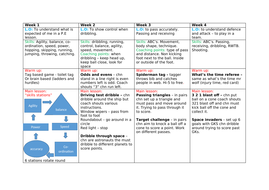Cool-down activities focus on slow movements and stretching, allowing the heart rate to return to normal after vigorous activity. Use full body stretches to work on improved flexibility. Cool-down activities also help to prepare the children for the transition back into the classroom setting. Use the following activities to gradually slow down movement and provide a period of relaxation. Take long, slow, deep breaths during the cool-down.
Side Arm Circles
Fun PE Running Games. The following five PE running games are fun for students of all ages and will help you keep things fresh for your gym class. Red Light, Green Light. This classic running game is great for interval training as well as building physical endurance and listening skills. Now here are 4 cool down elementary physical education activities that my students enjoyed as well. Place the students in a circle with one student in the middle. The student in the center counts to ten to himself as a ball is passed around the circle from one student to the next. Start the game by giving one ball (a dodgeball works well) to a student. That student must roll the ball to another student, but not before calling the receiver's name first. It is important that only the receiver gets the ball, otherwise this game gets out of hand quickly. As the game progresses, introduce another ball into play. Included is numerous different ideas for starter and cool down activities for Games, Gymnastics and Dance. This activities can be adapted or incorporated into existing lesson plans and schemes of work. A booklet of warm up and cool down games i have collated from various websites.
- Marching on the spot, raise arms out from the sides of the body to shoulder height. Now slowly circle arms forward 8 –10 times and backward 8 – 10 times.
Circles in the Sky
- While marching on the spot, children raise arms overhead.
- Children pretend they are drawing circles in the sky. Children keep arms overhead and draw a variety of shapes.

Climb the Ladder
- Children stand with feet slightly apart.
- Move arms and legs up and down as if climbing a ladder to the sky.
- Climb a ladder for 20 – 30 steps.
On-the-Spot Follow the Leader
Choose a leader to lead some slow, cool-down movements:
- Walk on the spot, moving arms in a gentle swinging motion.
- Touch shoulders with hands, then reach up over head. Repeat five times.
- Skip slowly on the spot.
- Skip side to side.
- Jump or hop on the spot.
Slow March
- March slowly on the spot, keeping knees low and gently swinging the arms for 15 counts.
Skating on the Spot
- While standing on the spot, imitate a skating motion by extending the right then left leg away from the body at a back/side angle.
- Swing the arms.
- Continue this skating motion for 15 – 20 counts.
- Variation: children can “skate” around the gym either by pretending to have skates or by standing on scrap paper, and using the paper as skates.
Deep Breaths and Hug
- Slowly take a deep breath in through the nose and out through the mouth. Repeat three times.
- Wrap arms around shoulders and give self a big hug and a pat on the back.
Low Kicks
- A variation of walking on the spot, with children alternating their feet in low forward kicks.
- Slowly swing arms by sides.
Tree in the Wind
- Stand with both arms overhead, feet placed wide apart, and knees slightly bent.
- Gently wave arms from side to side and forward like a tree in the wind.

Slow Leak
- Stand, arms circled over their heads, pretending to be a great big balloon.
- Pretend there is a hole in the balloon and the air is slowly leaking out.
- Move slowly downward to the floor, until the balloon has no more air.
Digging in Your Heels
- Stand with one foot forward, pressing heel into the floor and raising toes up.
- Continue this movement while alternating feet, swinging arms in a strolling movement.
Action Stories

Tell a story with actions that the children can do. Here are some theme suggestions:
- Rainstorm coming and then leaving, with fingers and hands tapping the floor in beat to the intensity of the rain.
- Walk through the forest, listening to the birds and the wind in the trees.
- Visit to a planet in outer space, exploring new terrain.
Strolling on the Spot
- Begin by standing on the spot. Stroll one step forward, then one step back, one step forward, then one step back gently swinging arms by sides. Do not raise arms above waist. Continue “strolling” on the spot for 20 – 30 counts.
Bubble Gum Game
- Children pretend to be a piece of bubble gum that is being chewed.
- Children expand like a bubble blowing up, then “pop”, the bubble breaks!
Body Shake
- Gently shake one arm, the other, both.
- Shake one leg, the other, both, head, hips, whole body.
Running is one of the simplest and most basic ways the human body is built to move—which is probably why it’s on almost every physical education teacher’s agenda, regardless of their students’ ages or grade levels. But just because running is fundamental doesn’t mean it has to be boring. Instead of heading out to the track to run laps, why not spice up the routine?
The following five PE running games are fun for students of all ages and will help you keep things fresh for your gym class.

1. RedLight, Green Light
This classic running game is great for interval training as well as building physical endurance and listening skills. Students line up at the starting line, and as soon as the teacher calls out “green light,” everyone starts running as fast as they can toward the finish line. When the teacher calls out “red light,” all the runners must freeze in place until the teacher calls out “green light” again. If the teacher calls out “yellow light,” the students must slow their pace until it’s time to freeze or run once again.
2. Band-AidTag
There is one Tagger and two Doctors in this silly twist on tag and the rest of the students are potential Patients who run to avoid being tagged. When runners are tagged, they must hold a “Band-Aid” (a hand) over the spot where they were tagged and continue running. If they’re tagged a second time, they have to hold their other hand over that spot as well and keep going. If they’re tagged a third time, they’re out of “Band-Aids” and become Patients, which means they have to freeze and wait for the Doctors to come “operate.” Both Doctors must tag a frozen player at the same time in order to “operate” and “heal,” or un-freeze, the Patient, so the player can start running again. This game gets goofy when the Tagger tags runners on silly or hard-to-reach spots like their heads, knees or backs!
3. SharksAnd Minnows
Cooldown Games Elementary P.e. Games To Play
This game might seem childish, but it can be lots of silly fun for all ages and in almost any space, whether you’re holding class in a gym, on a basketball court or in a field. Designate one student as the shark, and have them stand in the center of the play area. All the other students are the fish and should line up side-by-side at one end of the area. All the fish call out in unison, “Shark, shark, may we cross your ocean?” When the shark responds, “Go, minnows, go,” every student runs for the far side of the play area, trying to avoid being “eaten” (tagged) by the shark. If a runner is tagged, he or she then becomes a second shark and works with the first to tag other fish. The round or game is over when there’s only one minnow left.
4. WackyLaps
Cooldown Games Elementary P.e. Games Youtube
There are times when running laps around a quarter- or eighth-mile track is necessary—but it never has to be boring. To make running laps more fun and interesting for your students, introduce Wacky Laps, in which they run every lap in a different (and wacky!) way. Students can run the first lap to music, the second lap backward, and the third lap as slowly as possible. They can run a lap weaving among cones, another while holding hands with a partner and another jumping over mini-hurdles (such as bean bags or any other small item that won’t trip them up). Letting the students brainstorm their own Wacky Laps is another great way to keep them engaged.
5. Criss-CrossRelay
Relay races are another great way to blend running practice with interval training and teamwork. For this whole-group relay, divide students into four groups and have each group line up in the four corners of your gym or play area. Designate the first runner—the first student in one of the lines, who will run diagonally across the play area to the group at the far corner, high-five the first runner there, and go to the end of that line. Meanwhile, the second runner (who received the high-five) has taken off to the third corner’s group to high-five that group’s first runner and head to the back of that line. That third runner will run diagonally across the area to high-five the fourth group’s first runner—and so on. The running pattern follows a continuous hourglass shape. To switch things up, have two students run at a time, and always diagonally across the play area, to create an X-shaped running pattern.
Want more? Read Indoor PE Games and Outdoor PE Games!
ABOUT MARATHON KIDS
Marathon Kids is on a mission to get kids moving. The nonprofit organization offers free physical education programming through Marathon Kids Connect, a cloud-based PE and run club management platform that includes a mobile app for digital activity-tracking.
